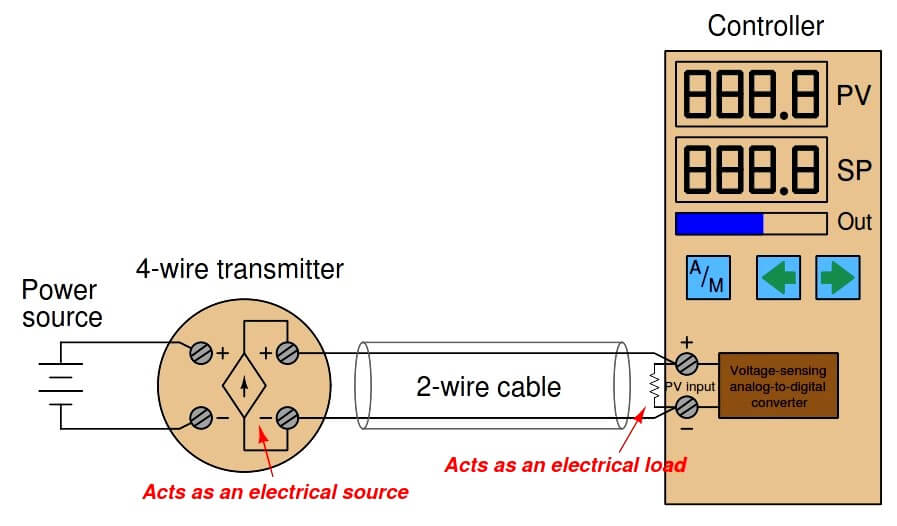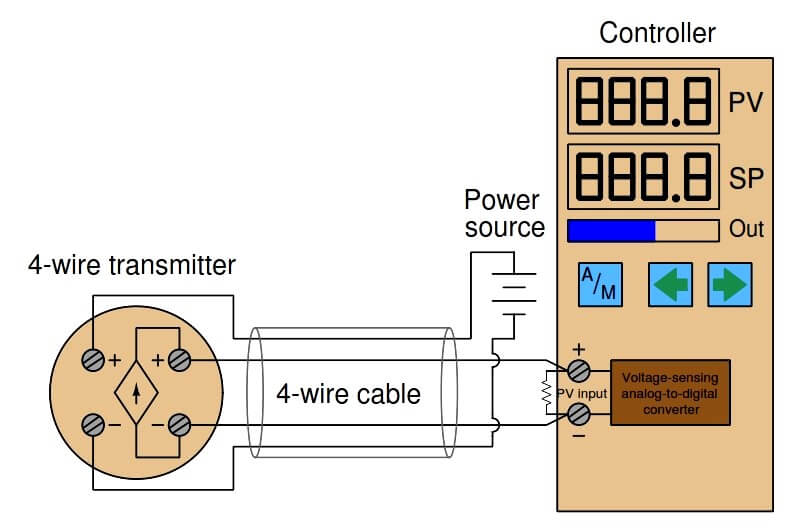4-wire (“self-powered”) Transmitter current loops
DC electric current signals may also be used to communicate process measurement information from transmitters to controllers (PLC/DCS), indicators, recorders, alarms, and other input devices. Recall that the purpose of a transmitter is to sense some physical variable (e.g. pressure, temperature, flow) and then report that quantity in the form of a signal, in this case a 4 to 20 milliamp DC current proportional to that measured quantity.
The simplest form of 4-20 mA measurement loop is one where the transmitter has two terminals for the 4-20 mA signal wires to connect, and two more terminals where a power source connects. These transmitters are called “4-wire” or “self-powered” units. The current signal from the transmitter connects to the process variable input terminals of the controller to complete the loop:
Note :
- Here in this article, we are assuming a simple microcontrollers based controllers is connected with a 4 wire transmitters.
- For a PLC/DCS systems, the standard resistor & Analog to Digital Converters (ADC) are found in Analog Input (AI) Cards.

Some process controllers are not equipped to directly accept milliamp input signals, but rather can only interpret DC voltage signals. In such cases we must connect a precision resistor across the controller’s input terminals to convert the 4-20 mA transmitter signal into a standardized analog voltage signal the controller can understand.
A voltage signal range of 1 to 5 volts is standard, although some models of controller use different voltage ranges and therefore require different precision resistor values. If the voltage range is 1-5 volts and the current range is 4-20 mA, the precision resistor value must be 250 ohms according to Ohm’s Law.
Since this is a digital controller, the input voltage at the controller terminals is interpreted by an analog-to-digital converter (ADC) circuit, which converts the measured voltage into a digital number the controller’s microprocessor can interpret.
In some installations, transmitter power is supplied through additional wires in the cable from a power source located near the controller:

The obvious disadvantage of this scheme is the requirement of two more conductors in the cable. More conductors means the cable will be larger-diameter and more expensive for a given length. Cables with more conductors will require larger electrical conduit to fit in to, and all field wiring panels will have to contain more terminal blocks to marshal the additional conductors. If no suitable electrical power source exists at the transmitter location, though, a 4-wire cable is necessary to service a 4-wire transmitter.
Credits : by Tony R. Kuphaldt – Creative Commons Attribution 4.0 License
4-wired transmitters here the 4 wires means 2 wires for analog signal (normally 4~20 mA) and 2 wires for pure power supply.
4-wired transmitters need much higher working voltage and working current to satisfy the device functionality (compare with 2-wired loop powered transmitters).
Typical 4-wired transmitters in the market are: Coriolis Mass Flow Transmitter, Ultrasonic Flow Transmitter, Electromagnetic Flow Transmitter, etc.
The power supply request have two versions, i.e., DC and AC, but most popular is the AC version since there is normally no voltage drop issue.
Additional power cable pulling from power distribution cabinet to field transmitter have to be considered during engineering phase.
Currently, maybe you only can find the 4-wired transmitters in the market but instrument vendor product development target is to develop the 2-wired version eventually in the future. The 2-wired version is less complexity on wiring issue and likely by instrument engineers.